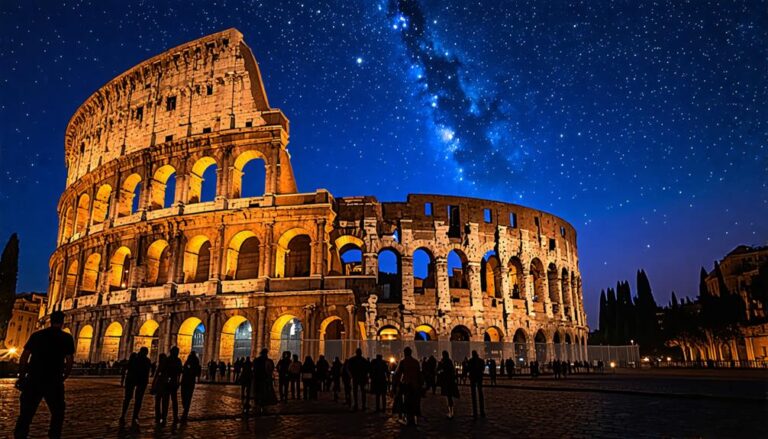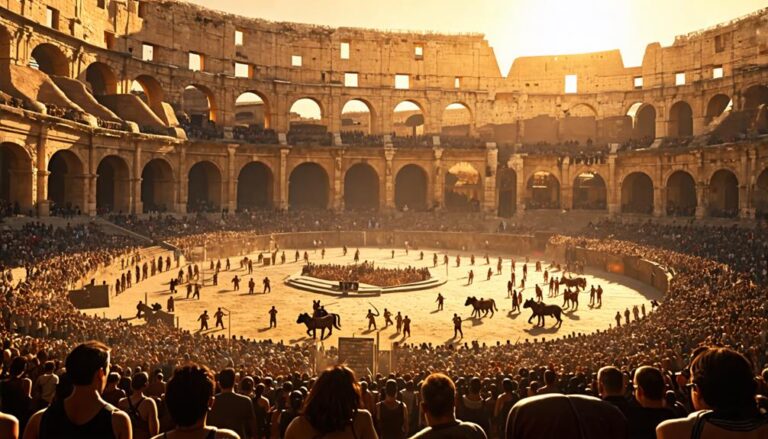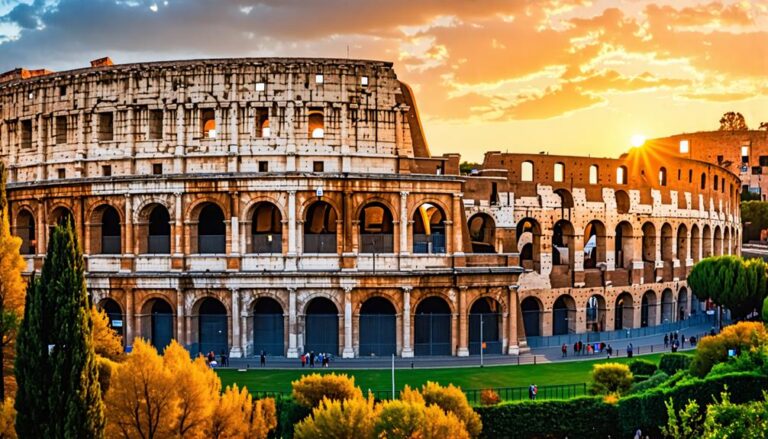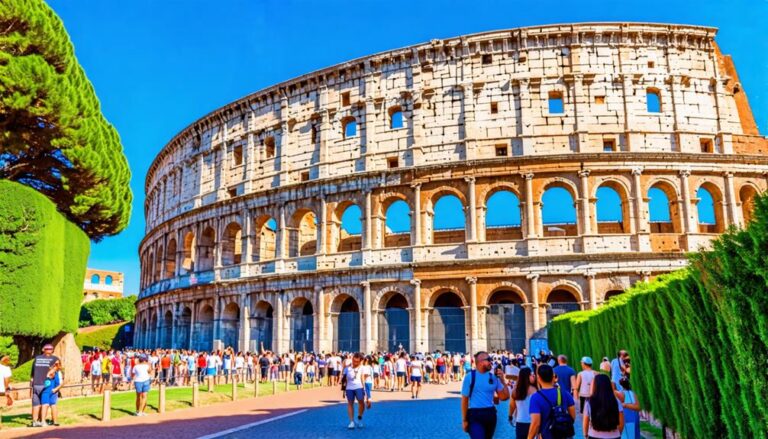The Colosseum: Symbol of Roman Engineering
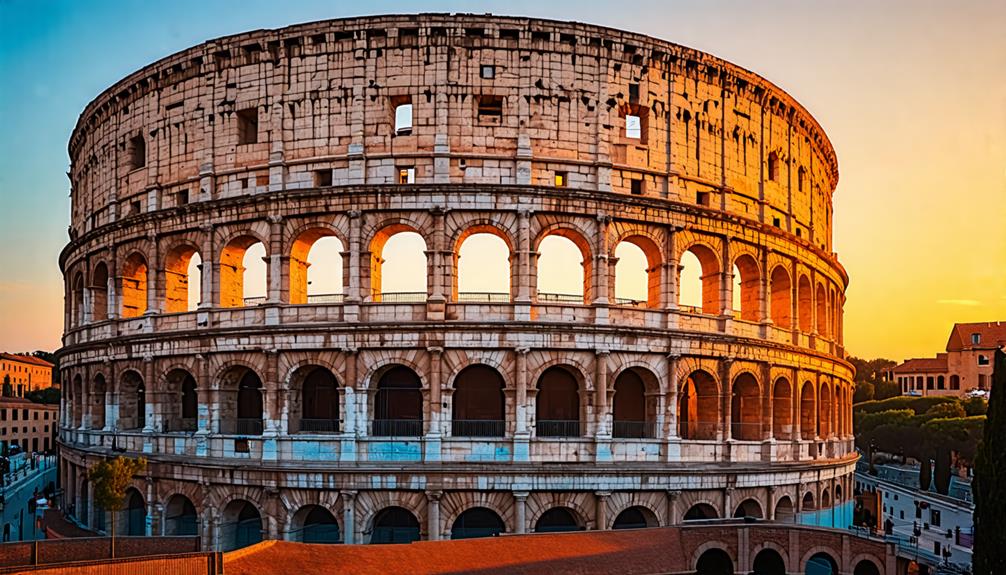
The Colosseum, commissioned by Emperor Vespasian in 72 AD, stands as a testament to Roman engineering genius. Built swiftly in eight years using advanced techniques like concrete vaulting and a complex drainage system, it accommodated up to 80,000 spectators.
Its modular design made repairs easy, and using resources from the Roman conquest of Jerusalem highlighted the empire's might. Skilled Roman laborers and about 12,000 Jewish slaves built it, demonstrating expertise in stone-cutting and carpentry.
This iconic structure, enduring centuries of wear and restoration, offers deep insights into Rome's architectural legacy and societal grandeur. It piques interest for further exploration into its historical impact.
Visiting the Colosseum is a must for anyone on vacation in Rome. As you walk through the ancient amphitheater, imagine the roar of the crowds and the spectacle of gladiators. The sheer size and intricate design will leave you in awe.
You'll discover how this marvel was not just an entertainment venue but also a symbol of Roman power and innovation. Every corner tells a story, from the underground chambers to the towering arches.
Don't miss the chance to explore the nearby Roman Forum and Palatine Hill. These sites provide a fuller picture of ancient Rome's grandeur. As you wander, you'll feel the history beneath your feet.
It's an experience that blends education with awe, making your trip to Rome unforgettable.
Key Takeaways
When you vacation in Rome, the Colosseum is a must-see. This iconic structure stands as a testament to Roman engineering. Its vaulted arches and sophisticated drainage system are marvels of ancient technology.
The use of prefabricated concrete blocks and a modular design enabled rapid construction. It also made repairs easier. Roman concrete, made from volcanic ash, lime, and water, offered unmatched strength. It even withstood earthquakes over the centuries.
The Colosseum's elliptical shape ensured every one of its 50,000 spectators had a clear view. The design also allowed for efficient crowd management with 80 entrances.
The Hypogeum, the underground part of the Colosseum, featured innovative trap doors and hydraulic lifts. These added to the drama of the events and helped manage the crowds.
When you visit, you'll see why the Colosseum remains one of Rome's most popular attractions.
Historical Context
Let's dive into the fascinating history of the Colosseum, an iconic landmark in Rome. Emperor Vespasian commissioned this grand structure in 72 AD. His goal? To signify Rome's revival after civil wars and the Great Fire. The Colosseum stands as a proud symbol of the Roman Empire's strength and ingenuity. By building it on the site of Nero's lavish Domus Aurea, Vespasian aimed to distance his reign from Nero's extravagance. This also showed the Flavian dynasty's commitment to the people of Rome.
Funding for this colossal project came from the wealth amassed during the Roman conquest of Jerusalem. This showcased the Empire's vast resources. The Colosseum, also known as the Flavian Amphitheatre, was an architectural marvel. It employed advanced engineering techniques. Vaulted arches, robust columns, and a sophisticated drainage system exemplified the ingenuity and skill of Roman builders. Skilled Roman laborers and thousands of Jewish prisoners worked together to bring Vespasian's vision to life.
When visiting Rome, a trip to the Colosseum is a must. Imagine the ambition and expertise that created this iconic structure. It remains a symbol of the enduring legacy of the Roman Empire and its engineering prowess. Experience the awe-inspiring architecture that has stood the test of time. You'll be walking through history, surrounded by the grandeur of an empire that once ruled the known world.
Construction Timeline
Construction of the Colosseum started between AD 70-72, directed by Emperor Vespasian, and finished in AD 80 under Emperor Titus. Nero's artificial lake became an iconic amphitheater, symbolizing public reclamation. Our ancestors marveled at Roman engineering, blending practicality with grandeur.
Rising in Rome's heart, the Colosseum showcased rapid assembly with innovative techniques. Concrete foundations provided stability, and the intricate design accommodated between 50,000 to 80,000 spectators. This wasn't just a building; it was an experience for the masses.
The amphitheater's completion began 100 days of inaugural games, displaying Rome's might and cultural flair. Gladiatorial games, animal hunts, and elaborate spectacles captivated audiences, fostering unity and shared identity. Emperor Vespasian's vision and Emperor Titus's execution created a structure reflecting Roman ingenuity and public spirit.
The Colosseum's construction symbolizes our collective ability to create, innovate, and inspire. Today, it stands as a must-see for Rome visitors, offering a unique glimpse into ancient Roman life and architecture.
Funding and Resources
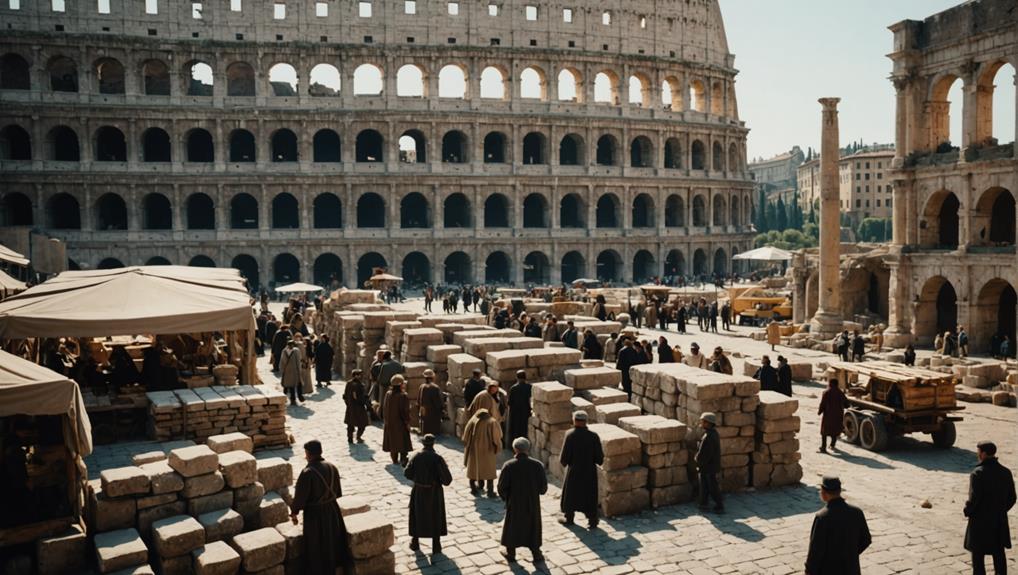
The Colosseum's construction was funded by the spoils of the Roman siege of Jerusalem. This wealth showcased Rome's riches from military conquests. Looting the Jerusalem Temple provided the financial backing. This massive infusion of wealth didn't just underline Rome's might; it boldly stated their dominance and capability.
To bring this monumental structure to life, Jewish slaves were mobilized. This emphasized the human cost behind the grandeur. About 12,000 Jewish prisoners were used, demonstrating the scale of labor required. The materials used were equally impressive. Approximately 100,000 cubic meters of travertine limestone formed the backbone of the Colosseum, highlighting the vast resources at Rome's disposal.
Rome's advanced engineering techniques played a significant role in the construction. Standardized parts for seating were employed. This ensured efficient management and swift assembly. These methods sped up the process and set a precedent in architectural innovation. Each element, from funding to materials and engineering, was meticulously orchestrated. This reflects Rome's unparalleled expertise in turning vision into reality.
When you visit Rome, the Colosseum is a must-see. Its history whispers through the ancient stones. You can almost hear the echoes of the past. Standing before this iconic structure, you feel the weight of history and human endeavor.
It's a remarkable testament to Rome's ambition and ingenuity. The Colosseum isn't just an architectural marvel; it's a symbol of the heights of human creativity and the depths of human effort.
Enjoy your vacation to Rome. The Colosseum will leave you in awe.
Workforce and Labor
A vast workforce, including around 12,000 Jewish prisoners and skilled Roman laborers, powered the rapid completion of the Colosseum. These individuals formed the backbone of this massive construction effort, showcasing the Roman Empire's ability to mobilize and organize labor on an epic scale.
The combination of forced labor and the expertise of specialized Roman craftsmen allowed for the use of advanced construction techniques, like the modular design that facilitated efficient assembly.
The human cost and organizational prowess involved in this monumental project can't be overlooked. The Roman laborers brought their engineering skills to the forefront, ensuring that each piece of the amphitheater fit perfectly. Their expertise in stone-cutting, carpentry, and metalwork was indispensable, transforming raw materials into the awe-inspiring structure we recognize today.
The exact number of laborers remains a topic of debate, but the effective use of such a large workforce undeniably contributed to the Colosseum's swift completion. This remarkable feat of construction stands as a testament to the Roman Empire's engineering capabilities and its capacity to orchestrate massive projects with precision and efficiency. Through this colossal undertaking, the Romans demonstrated their unparalleled ability to harness both human and material resources.
When you visit Rome, the Colosseum is a must-see. It stands as a symbol of Roman ingenuity and determination. Walking through its ancient corridors, you can almost hear the echoes of the laborers who built it. The structure's grandeur and historical significance make it a highlight of any trip to Rome.
Concrete Foundations
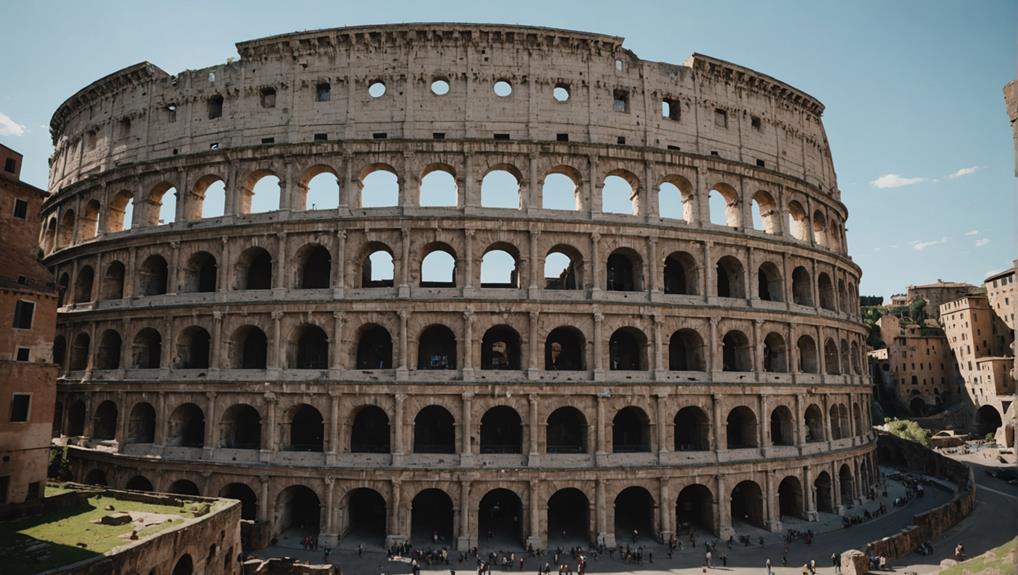
When you visit Rome, the Colosseum is a must-see. The massive amphitheater stands as a symbol of Roman engineering prowess. Its concrete foundations are a marvel. Romans used volcanic ash to make their concrete more durable. This unique ingredient helped the Colosseum support huge crowds and resist earthquakes.
Exploring the Colosseum, you'll notice the sheer scale of the structure. The Romans had a deep understanding of construction. Their techniques ensured the amphitheater's stability. This knowledge is why the Colosseum has stood the test of time.
A vacation to Rome isn't complete without seeing this iconic landmark. The Colosseum's enduring legacy is a testament to Roman innovation. From its robust foundations to its grand design, every aspect reveals their genius.
Roman Concrete Mastery
When you vacation in Rome, the Colosseum stands out as a must-see marvel. Roman engineers didn't just build this iconic structure; they mastered concrete technology to create a foundation that has withstood the test of time. Using Roman concrete, a unique mix of volcanic ash, lime, and seawater, they crafted a structure capable of enduring immense weight and stress.
The Colosseum's massive elliptical shape was designed to hold thousands of spectators. Advanced Roman engineering techniques, like concrete arches and vaults, added both strength and flexibility. These features have allowed the Colosseum to remain stable for centuries.
The foundation's success comes from its solid concrete base, which managed the challenging soil conditions of the site. Roman engineers employed a modular design with standardized concrete parts. This ensured the Colosseum could be assembled quickly and repaired efficiently. This approach showcased their technical prowess and their ability to innovate within their environment's constraints.
Your appreciation for this engineering feat will grow when you consider the complexity and foresight required to pull it off. Roman concrete wasn't just a building material; it was a revolutionary tool. It enabled the creation of one of the ancient world's most enduring symbols of freedom and ingenuity.
Foundation Stability Techniques
Standing on the Colosseum's solid concrete base, we marvel at the ingenious foundation stability techniques that have kept this ancient wonder upright for centuries. The Romans showcased their engineering prowess with these methods, ensuring the Colosseum's longevity and resilience. Central to this stability is the use of Roman concrete, which included volcanic ash, giving it remarkable durability and strength.
A key element in this stability is the complex network of vaulted arches. These arches distribute weight evenly, preventing excessive stress on any single point and enhancing the overall strength of the structure. The Romans also implemented an efficient drainage system within the foundation to manage rainwater. This system prevents water accumulation, which could otherwise undermine the foundation's integrity.
| Foundation Stability | Technique | Benefits |
|---|---|---|
| Concrete Base | Roman concrete | Durability and long-lasting |
| Weight Distribution | Vaulted arches | Even weight distribution |
| Water Management | Drainage system | Prevents water accumulation |
The design prioritized the use of standardized parts and modular construction methods. This allowed for efficient assembly and straightforward repairs, ensuring that the Colosseum could withstand the trial of time. Thanks to these sophisticated foundation stability techniques, the Colosseum remains a symbol of Roman ingenuity and engineering excellence.
When you visit Rome, you can witness this marvel firsthand. The Colosseum stands as a testament to ancient engineering. It's a must-see on any Roman vacation. You'll be walking on history, surrounded by the ingenuity of a civilization that set the foundation for modern architecture.
Exploring the Colosseum gives you a glimpse into the past. You can almost hear the roar of the crowds and feel the grandeur of ancient Rome. It's an experience that blends historical evidence with the tangible reality of Roman engineering. So, when planning your trip to Rome, make sure the Colosseum is at the top of your list. It's more than a sightseeing spot; it's a journey through time.
Innovative Building Materials
Let's dive into the fascinating history and innovative building materials that make the Colosseum a must-see on your Rome vacation.
Roman concrete, made from volcanic ash, lime, and water, revolutionized construction. This unique material offered unmatched strength and durability, outlasting many traditional stone structures.
The Colosseum's location posed a huge challenge. Built on what used to be the lake of Nero's Domus Aurea, it required advanced engineering solutions. The concrete foundations provided the necessary stability, ensuring the amphitheater could endure the test of time and natural disasters, including earthquakes.
The Romans didn't just use concrete; they innovated further by employing prefabricated concrete blocks. This technique sped up the construction process, allowing the massive structure to be completed in just eight years. The brilliance of their methods lies in both the materials and their application.
Roman engineering also combined concrete with vaulted arches. This enhanced both strength and efficiency. It minimized weight while maximizing structural integrity. These advanced techniques created a lasting symbol of Roman architectural prowess, a tribute to their quest for excellence through innovative engineering.
When you visit the Colosseum, you'll be standing in a marvel of ancient technology. It's a testament to the ingenuity and ambition of the Roman Empire. Make sure to take a moment to appreciate the incredible history and engineering that went into creating this iconic landmark.
Architectural Design
The Colosseum's architectural design, with its elliptical shape and layered columns, is a testament to the brilliance of ancient Roman engineering. This grand amphitheater spans 620,513 square feet, accommodating over 50,000 spectators and ensuring peak visibility from every seat. The Romans showcased their architectural mastery by incorporating Doric, Ionic, and Corinthian columns across three distinct stories.
To achieve such an impressive structure, architects used advanced techniques like barrel and groin vaults. These methods allowed the Colosseum to maintain its massive size while reducing weight, crucial for structural integrity. The complex system of arches and vaulted ceilings not only added beauty but also guaranteed stability and durability.
Its elliptical shape allowed for an unobstructed view from all seating areas. The mix of different column styles demonstrated Roman versatility in architecture. The use of barrel and groin vaults highlighted advanced engineering techniques.
Further enhancing the Colosseum's functionality, Emperor Domitian added the hypogeum—an underground complex with two levels designed for the efficient movement of performers and animals. This ingenious design was essential for crowd management and operational efficiency. The Colosseum stands as a monument to Roman architectural prowess and their enduring legacy.
When planning your vacation to Rome, visiting the Colosseum should be at the top of your list. This iconic landmark offers a glimpse into the grandeur of ancient Rome. You can marvel at the ingenuity of its design and appreciate the historical significance of this enduring masterpiece.
Innovative Engineering
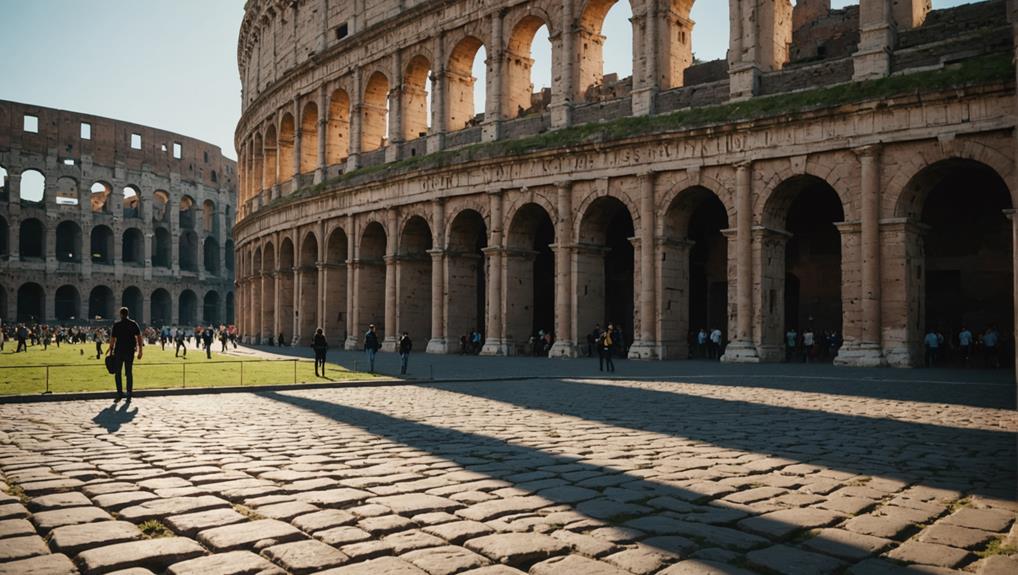
Visiting Rome, the Colosseum is a must-see landmark. This ancient amphitheater showcases remarkable engineering feats. The Romans used concrete for its unmatched strength. They also built vaulted arches and groin vaults for extra support.
The Colosseum's hypogeum, an underground network, reveals their intricate planning. They designed it to manage large crowds efficiently. Their advanced drainage systems ensured smooth operations even during heavy rains.
Exploring the Colosseum offers a glimpse into Roman ingenuity. It stands as a testament to their architectural brilliance and innovative spirit.
Advanced Construction Techniques
We marvel at the Romans' advanced construction techniques when visiting the enduring Colosseum. This architectural marvel stands as a testament to their ingenuity and valued engineering. By integrating a modular design, they made construction efficient and adaptable for future repairs.
The Colosseum's foundational strength comes from its use of concrete and vaulted arches, innovations that allowed it to support massive weight and accommodate over 50,000 spectators. The Romans' attention to detail didn't stop there. They incorporated a sophisticated drainage system, ensuring rainwater was effectively managed. This kept the arena operational regardless of the weather. Their commitment to functionality and durability is evident in these designs.
Key elements of their advanced construction techniques include:
- Concrete Foundations and Vaulted Arches: These provided the structural stability needed for such a large and enduring monument.
- Modular Design: Standardized parts facilitated rapid assembly and efficient repairs, showcasing Roman organizational prowess.
When visiting Rome, the Colosseum remains a must-see. It symbolizes architectural innovation and human creativity, embodying the spirit of Rome itself.
Efficient Crowd Management
Exploring the Colosseum on Your Roman Vacation
When you visit Rome, the Colosseum is a must-see marvel. The ancient Romans excelled at crowd management, ensuring smooth and organized movement for thousands of spectators. The Colosseum, designed with 80 entrances, allowed for quick access and exit, minimizing bottlenecks. This clever design could accommodate up to 50,000 people, showcasing their advanced engineering skills.
Crowd management went beyond just entrances and exits. Seating was carefully planned by social class, creating a harmonious experience for everyone. Separate corridors and staircases maintained order and safety during events. The elliptical shape of the Colosseum ensured everyone had a clear view, enhancing the spectator experience.
| Feature | Purpose | Impact |
|---|---|---|
| 80 Entrances | Quick access and exit | Reduced congestion |
| Social Class Seating | Organized by hierarchy | Maintained order |
| Separate Corridors | Dedicated pathways | Smooth crowd flow |
| Multiple Exits | Quick evacuation | Safety and efficiency |
| Elliptical Shape | Better sightlines | Improved spectator experience |
The multiple exits allowed the entire structure to be evacuated in about five minutes, demonstrating remarkable efficiency. The hypogeum, an underground complex, further streamlined operations, ensuring quick changes and keeping the crowd engaged. The Romans' focus on efficient crowd management reflects their dedication to creating a safe and enjoyable environment for all.
Structural Durability Innovations
When planning a vacation to Rome, visiting the Colosseum is a must. This iconic structure has stood the test of time, showcasing Roman engineering brilliance.
At the heart of its durability is Roman concrete. This unique material, made from lime and volcanic ash, gave the Colosseum exceptional strength and longevity.
The Colosseum's design features a network of vaulted arches. These arches distribute the weight evenly, making the structure resilient. They also allowed the Colosseum to safely hold over 50,000 spectators.
Iron clamps added extra stability. These 300-ton clamps held the travertine blocks of the outer facade together, preventing collapse from pressure and environmental stress.
- Roman concrete: Exceptional strength and longevity.
- Vaulted arches: Even weight distribution and enhanced durability.
These engineering marvels make the Colosseum a symbol of Roman ingenuity. When you visit, you'll see the incredible craftsmanship that has kept this monument standing for nearly two millennia.
Seating Arrangements
Amid the grandeur of the Colosseum, seating arrangements vividly mirrored the rigid social hierarchy of ancient Rome. Roman citizens, from emperors to commoners, found their places according to their social rank. The best seats, closest to the action, were reserved for the Emperor and the Vestal Virgins. Senators sat in the lower tiers (maenianum primum) with their marble seats, showcasing Rome's architectural sophistication. Equestrians sat in the middle tiers (maenianum secundum), while the general populace, including women and slaves, were relegated to the upper tiers.
The Colosseum's design accommodated around 50,000 to 80,000 spectators, ensuring that every Roman citizen had a designated spot. Seventy-six entrances provided access for ordinary citizens, while four main entrances were reserved for the elite, emphasizing the societal divide. Each tier was adorned with distinct column styles—Doric, Ionic, and Corinthian—reflecting the architectural prowess of the era.
Special provisions for crowd management allowed for efficient evacuation, demonstrating an advanced understanding of public safety. This meticulous organization of seating and exits showcased not just the grandeur of the Colosseum, but also the intricate planning that underscored Roman engineering brilliance.
Visiting Rome means stepping into history. The Colosseum stands as a testament to Rome's past splendor. When you walk through its ancient arches, you can almost hear the echoes of gladiators and the roar of the crowd. Planning your vacation to Rome, make sure to book tickets in advance. This helps skip long lines and ensures a spot in this iconic amphitheater.
Exploring the Colosseum, you'll see the different seating tiers. Imagine the Emperor sitting close to the arena, the Senators in their marble seats, and the commoners high above. The distinct column styles add to the visual treat. Doric, Ionic, and Corinthian columns tell a story of architectural evolution.
Don't forget to marvel at the engineering ingenuity. The Colosseum was designed for quick evacuation. Even with thousands of spectators, people could leave swiftly in case of emergencies. This shows the Romans' advanced understanding of public safety.
Your vacation to Rome will be incomplete without visiting the Colosseum. It's a blend of history, architecture, and engineering that offers a glimpse into ancient Roman life.
Hypogeum Features
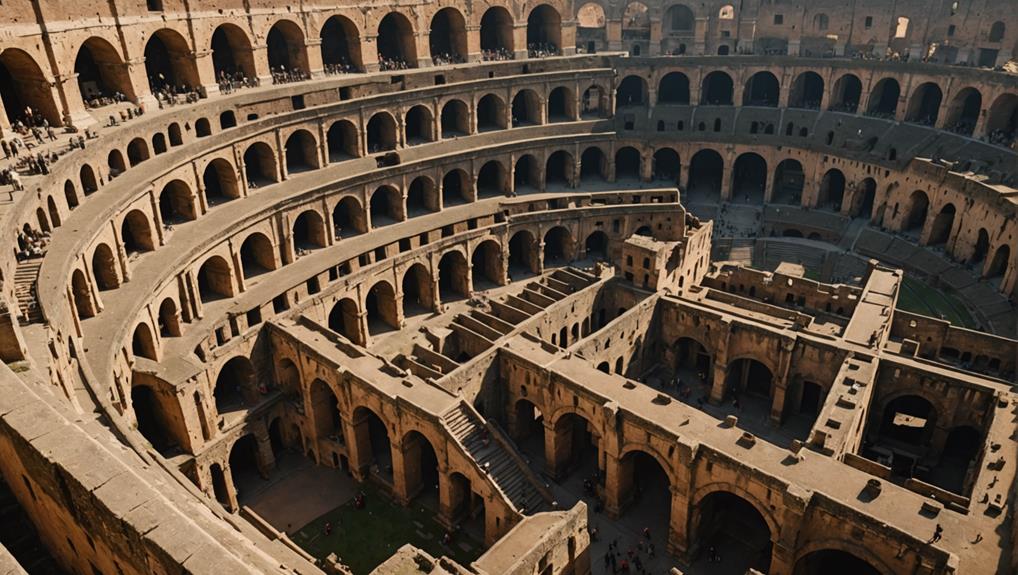
The hypogeum of the Colosseum, constructed under Emperor Domitian, showcases the ingenious engineering behind ancient Rome's grand spectacles. This subterranean marvel, with its two underground levels, was designed to store animals and equipment and provide quick access to the arena. Its advanced engineering included a complex network of tunnels and trap doors, transforming each event into a dynamic experience.
Let's explore some standout features:
- Trap doors: Around 36 strategically placed trap doors allowed for surprise entrances of gladiators and wild animals. This kept the audience captivated.
- Hydraulic lifting system: Known as Hegmata, this system efficiently moved heavy props and animals. It reflects the Romans' mastery of hydraulic engineering.
The hypogeum's design not only managed performances but also highlighted the Romans' understanding of crowd management and theatrical presentation. As we examine these features, we can appreciate the hypogeum's role in creating unforgettable spectacles. It showcases the brilliant minds behind ancient Rome's architectural achievements.
Entertainment Events
When visiting Rome, the Colosseum is a must-see. This ancient amphitheater offers a glimpse into Rome's rich history and architectural prowess. Gladiatorial combats, exotic animal hunts, and mythological performances once captivated up to 50,000 spectators here. The site reveals the ingenuity and extravagance of Roman engineering and culture.
Imagine the dramatic battles of gladiators, where life and death hung in the balance. Envision the awe-inspiring displays of mythological reenactments. The Colosseum stands as a testament to Rome's love for spectacle and power.
Don't miss exploring this iconic landmark on your Roman vacation. It's a vivid reminder of the empire's grandeur and a key highlight of any sightseeing tour in Rome.
Gladiatorial Combat Spectacles
When planning a vacation to Rome, a visit to the Colosseum is a must. This iconic structure once hosted gladiatorial combat spectacles that captivated ancient Romans. The Colosseum drew massive crowds eager for intense and often deadly entertainment. Up to 50,000 spectators would gather to watch gladiators, often slaves or prisoners of war, fight.
The Colosseum's design enhanced the dramatic presentation of combat. The wooden floor covered in sand absorbed blood, making the aftermath less gruesome for the audience. The hypogeum, or underground chambers, stored animals and equipment, adding surprise elements. Elevators and trapdoors allowed sudden appearances, heightening the drama.
The inaugural games in 80 AD, presided over by Emperor Titus, lasted for 100 days. They set a high bar for future spectacles. These events weren't just battles; they were grand productions with elaborate opening ceremonies that included parades and music.
These spectacles reflected ancient Rome's violent culture. The value of human life was often secondary to entertainment. The Colosseum became a symbol of societal values and engineering prowess.
Today, visitors can explore this architectural marvel. Walking through its corridors, you can almost hear the echoes of the past. It's a fascinating glimpse into history and a highlight of any Roman holiday.
Exotic Animal Hunts
Imagine the awe as you stand in the Colosseum, envisioning exotic animal hunts that once took place here. Lions, tigers, and bears from Africa and the Middle East roamed this arena. These wild creatures symbolized the grandeur and reach of the Roman Empire.
The sight of majestic animals battling gladiators or specially trained hunters captivated audiences. It showcased the empire's wealth and the bravery of those in the arena. The Colosseum's 36 trap doors and intricate hypogeum system allowed for dramatic and unexpected entrances, adding to the excitement for up to 50,000 spectators.
These events were more than just fights. They were well-orchestrated spectacles that highlighted Roman engineering genius and the empire's mastery over nature. The fights were perilous, often ending in the death of both animals and hunters. Combat could last for hours, keeping spectators on the edge of their seats.
Sometimes, these exotic animal hunts happened alongside gladiatorial contests and public executions. The Colosseum was a central hub for the most intense and brutal entertainment of the ancient world.
Visiting the Colosseum today, you can almost hear the roars and cheers that once filled this iconic structure.
Mythological Performances
In the heart of the Colosseum, mythological performances brought gods and heroes to life. These shows enchanted audiences with intricate sets and costumes. They took place during festivals and special occasions, blending entertainment with Rome's cultural and religious practices. Skilled actors wore elaborate costumes to portray deities and legendary figures, creating a captivating spectacle for up to 50,000 spectators.
These performances reflected the Romans' deep reverence for their gods. They connected entertainment with cultural identity. Dramatizing famous myths and legends provided amusement and a sense of connection to the divine.
- Intricate sets: The Colosseum's interior transformed into various mythological landscapes, enhancing the visual experience.
- Talented actors: Performers trained to embody gods and heroes, enthralling the audience with their skill.
These mythological performances were a key part of the Colosseum's entertainment offerings. They showcased its versatility as a venue for diverse public spectacles, from gladiatorial games to grand theatrical productions.
If you're planning a vacation to Rome, visiting the Colosseum is a must. Imagine stepping into this ancient amphitheater and witnessing where these grand performances once took place. The Colosseum stands as a testament to Rome's rich history and cultural heritage.
Cultural Impact
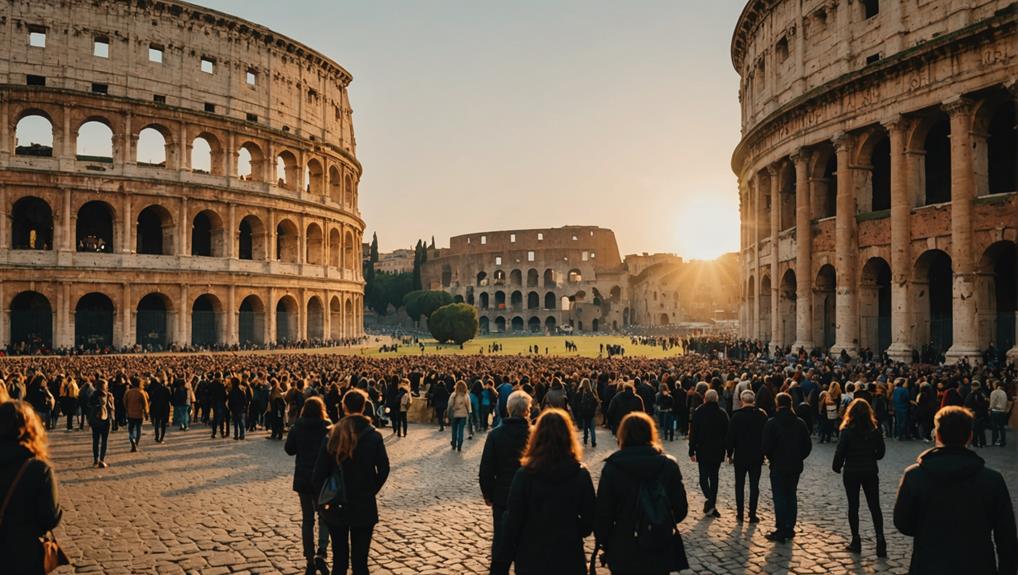
The Colosseum draws millions of tourists each year, serving as a powerful reminder of ancient Rome's cultural and social dynamics. This iconic structure isn't just a representation of Roman architectural innovations like the hypogeum and retractable awnings; it also offers insight into the cultural values that shaped the Empire.
The gladiatorial games held here were more than mere entertainment—they reflected the societal hierarchy, with seating arranged meticulously by class. These brutal events, including gladiatorial contests and venationes (animal hunts), served as a form of social control, providing a distraction for the populace and reinforcing Rome's hierarchical structure.
The Colosseum's ability to host such complex spectacles highlights its architectural brilliance, influencing modern stadium designs. As we walk through its ancient corridors, we can't help but ponder the ethical considerations of such entertainment.
The Colosseum stands as a UNESCO World Heritage Site, symbolizing the complexities of Roman history. Its lasting impact isn't confined to ancient times; it continues to shape our understanding of power, spectacle, and the human condition. Through its towering arches and storied past, the Colosseum remains a cultural touchstone, connecting us to a world that valued both innovation and spectacle.
Damage and Restoration
The Colosseum is a must-see when vacationing in Rome. This ancient marvel showcases Rome's cultural and architectural greatness. Yet, it also tells a story of the challenges in preserving such a masterpiece. Over centuries, the Colosseum has faced significant damage. Major earthquakes, especially the one in 1349, led to the collapse of its southern side. Pollution and environmental wear have continually threatened its structure.
Restoration efforts have been ongoing since the 18th century. Bigger projects started in the 19th century, including adding buttresses to support weakened areas. In recent years, a massive restoration project funded by Della Valle, costing $33 million, has been in progress. This project has three stages:
- Cleaning the facade
- Building a visitor center
By 2016, these efforts aimed to ensure the Colosseum's structural integrity for future generations. In 2012, the hypogeum, the underground complex, opened for tours. This added to the visitor experience and educational value.
Ongoing restoration is crucial to fight deterioration from pollution and environmental factors. These efforts are vital to preserving the Colosseum's historical significance. We can continue to admire this symbol of Roman engineering for years to come.
Modern Significance
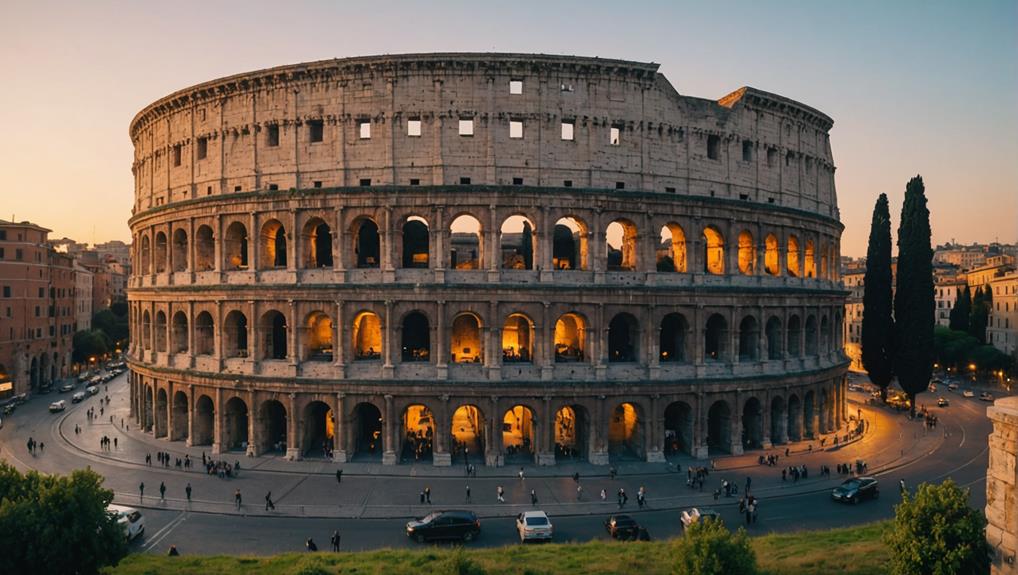
Standing as a testament to Rome's enduring legacy, the Colosseum continues to captivate millions of visitors each year. Attracting around 4 million people annually, this iconic structure remains a powerful reminder of ancient Roman engineering and societal complexity. Its status as a UNESCO World Heritage Site underscores its global significance, both as an architectural marvel and a symbol of the power that once dominated the ancient world.
We've seen how its elliptical shape and pioneering use of arches have influenced modern stadiums and construction techniques. The architectural brilliance of the Colosseum has left a lasting mark on contemporary engineering. Ancient innovations can stand the test of time and continue to inspire.
In recent years, the Colosseum has also served as a venue for modern Christian ceremonies. This shows its ongoing cultural and historical relevance. Extensive restoration efforts, including a $33 million project, highlight the commitment to preserving this monumental site for future generations. When you explore the Colosseum today, you honor its past and celebrate its enduring impact on modern architecture and society. Its presence reflects the timeless allure of freedom and human ingenuity.
Imagine standing in the heart of Rome, gazing at this ancient amphitheater. You can almost hear the echoes of gladiators and the roar of the crowd. Taking a vacation to Rome and visiting the Colosseum offers you a unique glimpse into history. The grandeur of this ancient marvel will leave you in awe.
Plan your trip, book your tickets, and prepare to step back in time. The Colosseum waits, ready to share its stories and secrets with you.
Frequently Asked Questions
What Was the Engineering Behind the Colosseum?
Exploring the engineering behind the Colosseum is incredible. The ancient Romans used advanced construction techniques and innovative design. They combined materials like concrete and stone to ensure structural stability. The Colosseum stands as a testament to Roman ingenuity and freedom.
When you visit Rome, seeing the Colosseum is a must. The massive amphitheater, built nearly 2,000 years ago, showcases the Romans' architectural brilliance. Walking through its arches and corridors, you can almost hear the echoes of ancient crowds.
The Colosseum's design included a complex system of vaults and arches. This allowed it to support thousands of spectators. The use of concrete, a Roman invention, enabled the construction of its grand, enduring structure. Stone and marble added both strength and beauty.
Roman engineers also devised an intricate system of underground tunnels and chambers. These were used to house gladiators and animals before they were brought up to the arena floor. This engineering marvel highlights their advanced understanding of mechanics.
Visiting the Colosseum connects you to a world of history and epic spectacles. It's a place where you can appreciate the brilliance of Roman engineering. You'll find yourself immersed in stories of the past and the grandeur of ancient Rome.
What Does the Roman Colosseum Symbolize?
The Colosseum stands as a monumental symbol of ancient Rome's cultural significance and historical impact. Its architectural brilliance captures our imagination. As a key attraction, it draws millions of tourists each year, reminding us of the grandeur of human civilization.
When you visit Rome, the Colosseum should top your list. This iconic amphitheater offers a glimpse into the past. It echoes stories of gladiators, emperors, and public spectacles. The structure itself, with its intricate design and massive scale, is a testament to Roman engineering prowess.
Exploring the Colosseum isn't just about seeing an ancient ruin. It's about experiencing a piece of history. Walking through its corridors, you can almost hear the roaring crowds and feel the excitement of ancient games. This makes it an unforgettable part of any Roman vacation.
The Colosseum also serves as a reminder of the complexity of human civilization. It shows both the heights of artistic achievement and the depths of human cruelty. Visiting this site allows you to reflect on these dual aspects of our history.
What Is Colosseum a Symbol Of?
The Colosseum stands as a symbol of Rome's history, architectural brilliance, and cultural impact. Its grandeur reflects the legacy of ancient Rome. The Colosseum's enduring presence captivates millions of tourists each year.
When planning a vacation to Rome, the Colosseum is a must-see. This iconic amphitheater offers a glimpse into the past. Built in 70-80 AD, it hosted gladiatorial contests and public spectacles. Its construction showcases ancient engineering marvels.
Visitors marvel at its towering arches and intricate design. The Colosseum is a testament to Roman ingenuity. It reminds us of both the glory and brutality of ancient Rome.
Exploring the Colosseum allows travelers to connect with history. Walking through its corridors evokes the atmosphere of ancient times. Each stone tells a story of emperors, gladiators, and spectators.
The Colosseum's influence extends beyond history. It plays a significant role in Rome's tourism industry. Millions flock to see this wonder of the ancient world. Its image is synonymous with Rome, appearing in countless photos and memories.
The Colosseum is more than a ruin; it's a symbol of Rome's enduring spirit. Its majesty continues to inspire awe and admiration. For anyone visiting Rome, the Colosseum is an unforgettable experience.
Is the Colosseum an Engineering Marvel?
Colosseum: A Must-See on Your Roman Vacation
When you visit Rome, the Colosseum must be on your list. This ancient amphitheater, built in AD 80, is an engineering wonder. The Roman builders used unique materials like travertine limestone, volcanic rock, and concrete, showcasing their advanced techniques.
The architecture is both functional and beautiful. The Colosseum could hold up to 80,000 spectators, a testament to its grand scale and efficient design. Its elliptical shape ensured everyone had a good view of the action, whether it was gladiatorial combat or public spectacles.
Visiting this iconic structure offers a glimpse into Roman history and ingenuity. The Colosseum stands as a symbol of Rome's architectural and engineering prowess. So, make sure to include it in your Roman sightseeing itinerary.
Conclusion
The Colosseum's rich history, innovative construction, and enduring cultural impact make it a must-see on any vacation to Rome.
This monumental structure, a tribute to Roman engineering prowess, continues to captivate visitors. Did you know that the Colosseum's design influenced modern stadiums? Evidence suggests it did, showcasing the Romans' lasting legacy.
Today, as we preserve and study the Colosseum, we honor this incredible engineering feat. We ensure its stories and lessons remain alive for future generations.
So, when you visit Rome, make sure to explore this iconic landmark. It's an experience that blends history, architecture, and culture in a way only Rome can offer.
